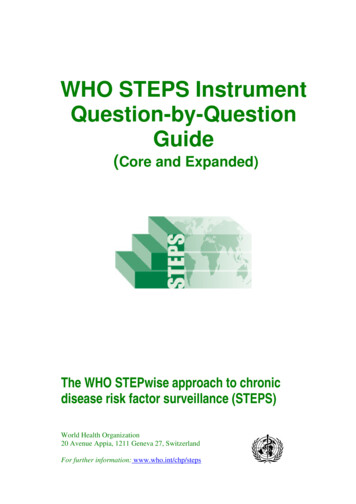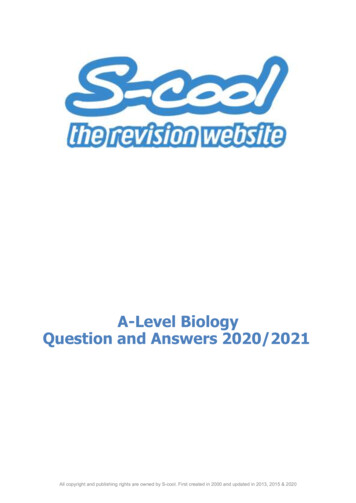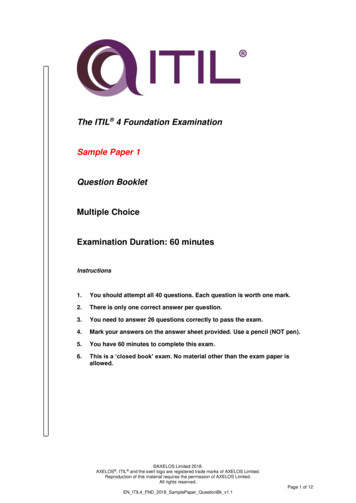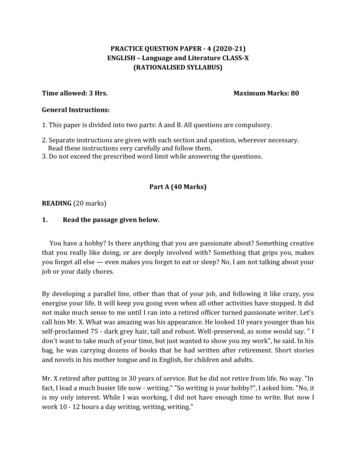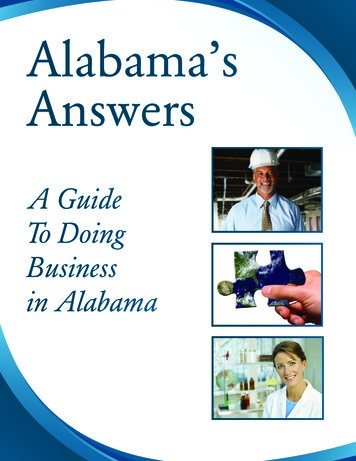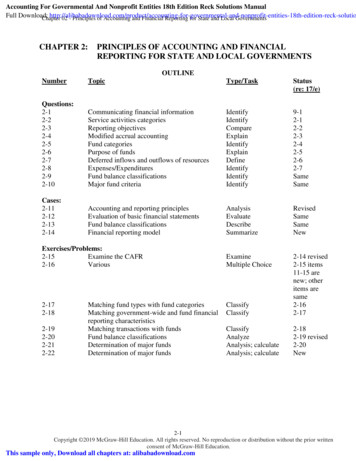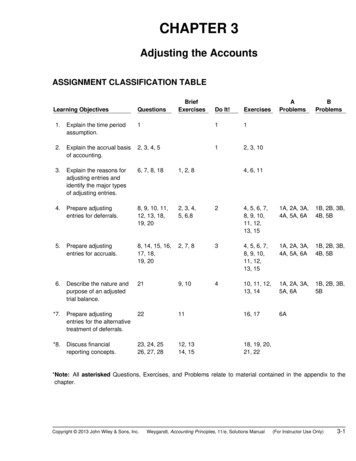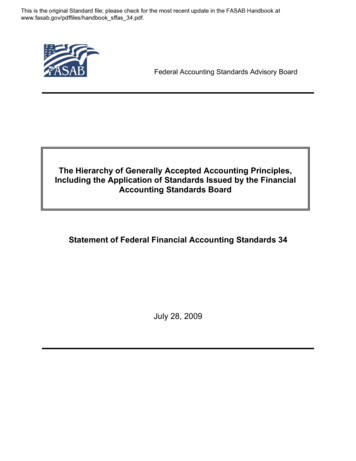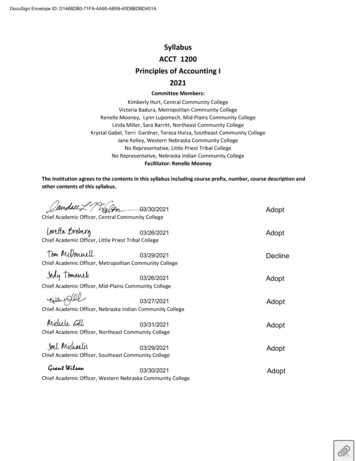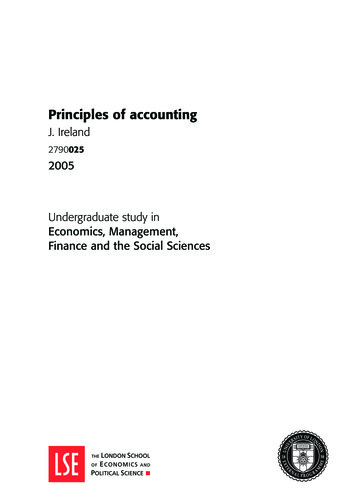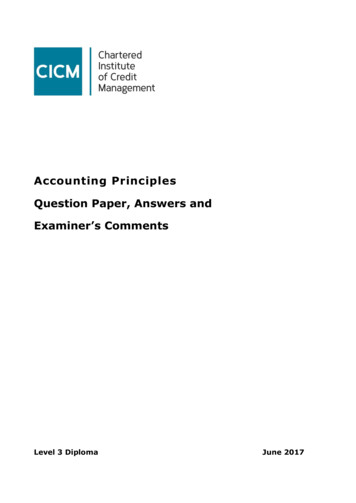
Transcription
Accounting PrinciplesQuestion Paper, Answers andExaminer’s CommentsLevel 3 DiplomaJune 2017
ADVICE TO CICM LEARNER CANDIDATESHOW TO TACKLE YOUR ACCOUNTING PRINCIPLES EXAMINATION1. Be prepared.Read the Accounting Principles unit syllabus contained in the Level 2 and Level 3Diploma in Credit Management Syllabus booklet, free to download from the CICMwebsite if you do not already have an up-to-date copy. It contains all the learningobjectives that might be tested in the examination, along with indicative content ofwhat the unit is about. You can use it to help plan your learning and to check you areadequately prepared.2. Examination structure and rubric.Remember that the unit syllabus and examination rubric changed in Summer 2016.Some features of the examination are now fixed, so you know that:a) It is a three-hour, handwritten examination and a writing booklet for your answersis supplied.b) There will be five (5) questions each worth an overall 20 marks.c) There are no optional questions or elements in the exam, so you will need toattempt them all. This is consistent with CICM’s other core units.d) Each question contains parts a), b) and c) which are worth different mark valuesup to the 20 available for the entire question. In each question, part a) will be astraight-forward task worth 4 marks, part b) will be some form of substantive taskfor between 10 and 12 marks, and part c) will be for remaining marks up to 20 andmay have some connection with or develop the part b) task.e) A certain amount of account ledger paper is included in the supplied writing booklet,so you do not have to draw account grids if you need to tackle a book-keeping task.f)The pass mark for a Level 2 exam is 40% and marks of 50% and above will receivea Level 3 pass. Unfortunately, marks below 40% are not pass marks.g) The language and terminology of the examination is based upon InternationalAccounting Standards as used in CICM’s own learning materials for this unit.3. General approach.More exams are failed through poor technique during the examination than from poorknowledge and understanding. The key things to do are:a) Read the detail within each question task very carefully, so you are sure what theexaminer is asking you to do.b) Allocate your examination time carefully. Remember that you should spendroughly the same time on each question overall, but that each question part willneed a different amount of time to be spent within that.c) Remember to attempt all parts of all questions.response, even if you are unsure of it.June 20177B/PQP/2It is always worth giving aContinued
4. Giving an effective response.As with any examination, preparation is the key and practising an effective responseto an Accounting Principles task is a worthwhile exam room skill, so it is worth areminder of what this unit and its exam is about.a) The unit and examination is written with the credit industry in mind, so often carriesa viewpoint of a customer relationship or credit control situation.b) The exam will require skills in description/explanation, application of the practicalprinciples of accounting, and commentary/narrative to convey the meaning of theprinciples, and the results of applying those principles.c) It is not, in itself, an assessment of mathematical ability, although accuratecalculations are important and unavoidable in this type of subject.d) There is plenty to write about too! It is not just about identifying what a numberis, but showing you understand what it means, and why or what its relevance is.e) The unit’s learning objectives also ask that you construct recognised financial andmanagement statements, undertake accurate tasks, and give explanations. Usethe published exam materials to practice this.f)It is worthwhile practising in advance not just the subject matter, but also how touse your non-programmable calculator if you choose to bring one to your exam.The following will help you give an effective response:a) Ensure you fully address the tasks set for you. They are not tripwires, but simplyto ensure that everyone sits same tasks and that marks are awarded fairly.b) Stick to the task and avoid drifting from the set task onto a tangent. Frequentlycheck with the task to ensure you are central to it, as that is where marks areavailable. Responses not on the set task, or which provide surplus-to-taskmaterial, waste exam time and are unlikely to score marks, even if accurate.c) Use clear, well-constructed, labelled and accurate layouts to help you get goodmarks. Where commentary or written explanation is required, it should be clearlyexpressed and relevant to the task. Whilst not needing a ‘beginning, middle, andend’ essay, remember these are opportunities for you to show your knowledge andunderstanding of the syllabus topics under question. A response which is easy tofollow is easy to mark.d) Take great care to ensure responses are not too brief for purpose. If the task wasto ‘explain what steps might be needed?’ there is a huge difference in responsequality (and therefore numbers of marks awarded) between stating that, e.g. morecare should be taken, and explaining why more care should be taken. Use linkingwords, such as ‘because’, or ‘meaning that’, or ‘such as’ to prompt a developed ontask response.e) Whilst bullet points can be carefully used in responses, ensure you develop eachpoint you make, rather than simply leave a bullet list absent of meaning andunderstanding, and absent of marks. Go back over bullet points and make suretheir meaning is clear. Note that whilst suggested response areas in unit pastquestion papers may be in the form of bullet point responses, you will see that eachbullet simply separates one discrete idea from another and that each bullet isextended and developed. This is a safe style if you choose to use bullet points.June 20177B/PQP/3Continued
f)Show workings and calculations to support your figures even if you used acalculator to produce or check your response. Even if your ‘number’ is incorrect, itmay still be possible to obtain marks from the methods you used where thatwas deemed part of the task.g) Practise extended writing by hand using a ball-point pen or similar – firstly, if youare accustomed to using a keyboard of whatever size to produce written text forwork and study, you might find handwriting at length may be quite tiring; secondly,it is an ideal opportunity to practice accurate recall of frameworks, and theextended and developed writing techniques discussed on these pages! Keephandwriting as legible as you can and help the examiner to read your response.Good luck! Copyright of the Chartered Institute of Credit ManagementJune 20177B/PQP/4Continued
Accounting PrinciplesLevel 3 Diploma in Credit Management questions, answers andexaminers’ commentsJUNE 2017Instructions to CandidatesAnswer all questions. All questions carry equal marks. Time allowed 3 hoursCandidates are reminded there are no optional elements in this examinationLedger accounts must be prepared in continuous running account balanceformatFinancial statements must be prepared in vertical formatFRS terminology should be used in responses wherever possibleCredit balances should be clearly shown in brackets ( ) for clarityWhere appropriate, VAT is to be calculated at 20%This was the second sitting of the Accounting Principles examination on the revisedsyllabus using the new structure of five compulsory 3-part questions and in the main itwas handled well by the majority of candidates. Most appeared conversant with theaccounting and bookkeeping principles, practices, concepts and methods featured inthe unit and there was good evidence of preparation and practice with regard tostructure, format and presentation of accounting data and information among thesound financial statements, double-entry bookkeeping and cash budgets submitted.That said, this is not a unit solely of numbers or arithmetic and there was animprovement in narratives explaining the results of given or calculated data.Candidates and learning supporters should be mindful that interpretation of results andcalculations remains an integral part of this unit and further improvement is still lookedfor. Nevertheless, congratulations are extended to candidates who were successful ateither Level 2 or Level 3, with best wishes for their achievements and their ongoingstudies.However, it was also noted that not everyone was able to achieve a pass this time.There was a smaller, but noticeable, number of candidates who were not able to offerresponses to every set task, or where responses given were brief, inaccurate, or did notevidence sufficient preparation and an appropriate volume of study practice for thisJune 20177B/PQP/5Continued
examination. This is obviously a concern. Perhaps it will be useful here to remindcandidates to resist the temptation to selectively study isolated parts of the syllabusand, in that respect, all candidates are referred to the syllabus indicative content andsyllabus topic weightings when planning both study and revision regimes. Whilstfurther comments are made where appropriate for individual tasks later, the followingobservations are made with regard to the importance in this subject of communication,accuracy and long-accepted practices in accounting and bookkeeping: The structure of some responses is important: for instance, because the structure offinancial statements (i.e. Income Statements and Statements of Financial Position)is defined in law, it is difficult to give credit for non-vertical or alternative structuresparticularly if they are not recognised. Furthermore, it is also difficult to reward theplacing of items to a statement if they are not done so appropriately, e.g. an assetplaced under a heading showing it as a liability, as this shows a lack of knowledgeand understanding. Many bookkeeping and accounting principles in the syllabus relate to practiceswhich are long-accepted over many years: double-entry bookkeeping was actuallydevised several centuries ago, so accuracy is anticipated even in examinationconditions, and it is not possible to reward very inaccurate work. Communication is a central part of accounting and bookkeeping, so even where astructure is not closely defined in law (e.g. for a budget), it must still effectivelycommunicate the data within it effectively (e.g. receipts and payments clearlymarked and listed separately, net cash flow clearly shown, etc.) and be supportedby a narrative if this is required by a task. Any financial statement or table of accounting information is always incompletewithout an appropriate heading to show what the information within it represents,and it was disappointing to note that a number of otherwise excellent financialstatements were poorly labelled, so did not attract all the marks available.Lastly, a reminder that the terminology used within the unit and its learning materialsis based upon international standards and it is firmly recommended that futurecandidates work with the CICM terminology, become familiar with it, and use it in theirpreparations for their examination.Questions start overleafJune 20177B/PQP/6Continued
1.a)Explain how a suspense account can be used as part of the book-keepingerror correction process.(4 marks)b)The following are extracted balances from Harbhajan’s business accounts alongwith other information relating to the business’s year end on 30 April 2017.For some reason, the figure for Capital at the beginning of the year has notbeen supplied, although you have been given the year end net profit figure: Capital as at 1 May 2016unknownMachinery at cost100,000Sales Revenue59,000Motor Vehicles at cost50,000Purchases25,000Trade Receivables13,500Trade Payables12,500Accumulated [provision for] depreciation: Machinery10,000HM Revenue and Customs: VAT (owing)7,750Net Profit as at 30 April 20177,105Accumulated [provision for] depreciation: Motor Vehicles5,000Water and Utilities4,500Inventory as at 1 May 20163,500Wages and Salaries3,500Rent3,000Bank (in funds)1,800Purchases Returns1,355Business Rates1,250Bad Debts written off1,150Sales Returns1,250Discounts Allowed950Cash in Hand760Drawings750Discounts Received550The Rent figure includes 600 relating to May, June and July 2017.The Machinery still has to be depreciated at year end by 10% straight line.There was unpaid Wages and Salaries at year end 30 April 2017 of 800.Stocktake at year end 30 April 2017 valued Inventory at 5,000.Motor Vehicles need year end depreciation (diminishing [reducing] balanceat 10%).June 20177B/PQP/7Continued
TASK for part b)Use the information given about Harbhajan’s business as appropriate toprepare a Statement of Financial Position for its year end, including themissing figure for Capital.(12 marks)c)Explain the problems from a working capital perspective for a business whichhas i) too many orders and ii) too few orders.(4 marks)Total 20 marksQuestion aimsTo test candidates’ ability to: Explain the place of a suspense account as part of the process to correct unresolvederrors detected by a trial balance Construct the financial statements for an unincorporated sole trader business,including adjustments Explain the importance of working capital in a business in decline or overtradingSuggested grounds for response include:a)A suspense account can be used as part of the book-keeping error correctionprocess as follows: Where the trial balance does not agree, in that the debit and credit columnscome to different hash totals, the difference is most likely caused by anarithmetical error or a combination of arithmetical errors. These are errorswhich are identified by an imbalanced trial balance and the imbalance shouldbe investigated and resolved. Examples of these errors might include omission of one side of the doubleentry, recording two debits or two credits instead of one of each, recordingdifferent amounts in the two entries or extracting account balances to the trialbalance incorrectl
accounting and bookkeeping principles, practices, concepts and methods featured in the unit and there was good evidence of preparation and practice with regard to structure, format and presentation of accounting data and information among the sound financial statements, double-entry bookkeeping and cash budgets submitted. That said, this is not a unit solely of numbers or arithmetic and there .
